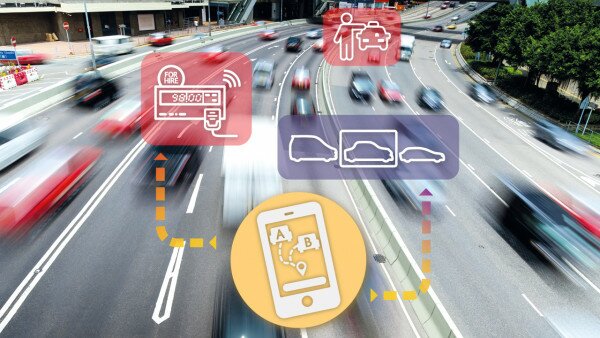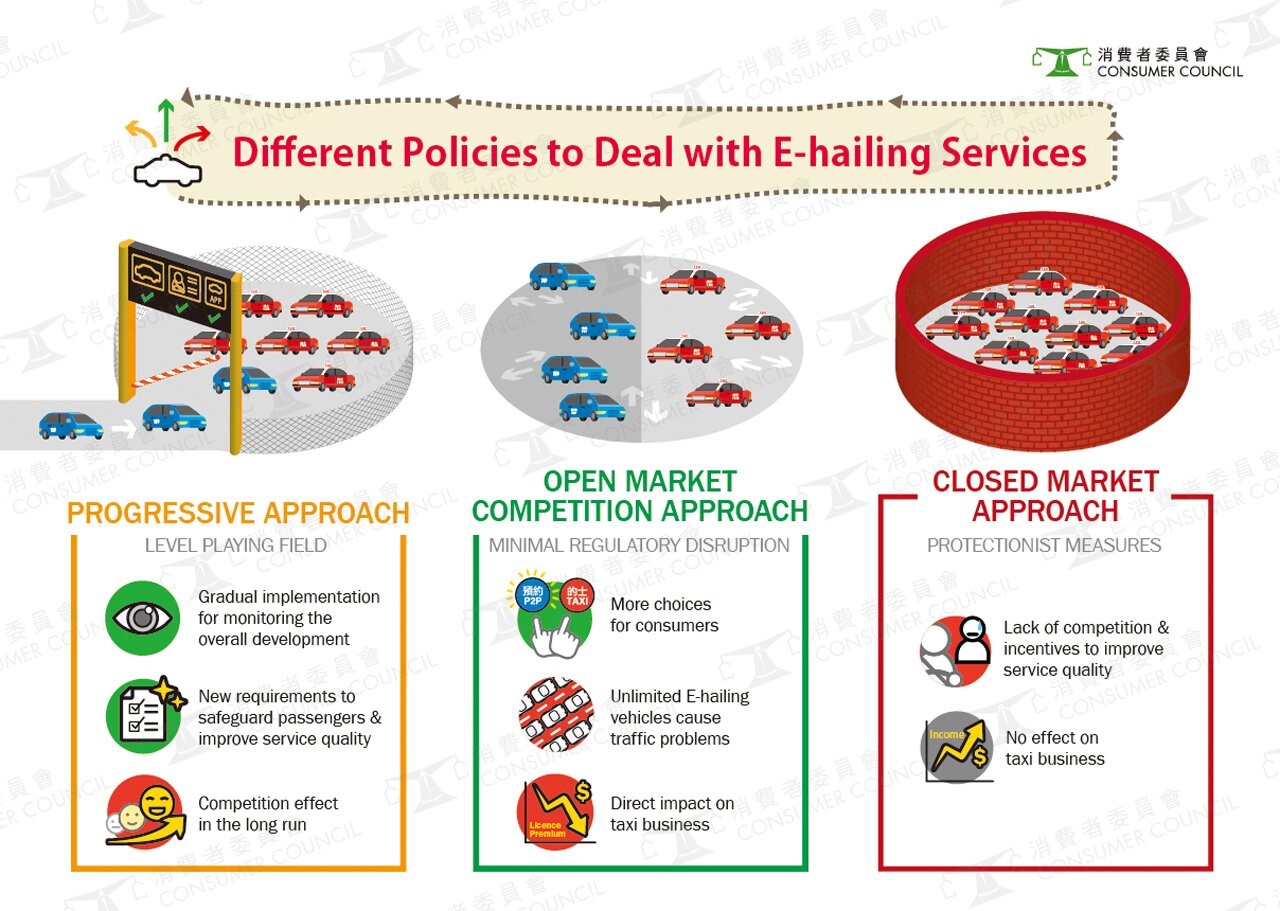Technological advances have disrupted many a traditional business model globally. The rapid emergence of E-hailing services, riding the wave of a burgeoning “sharing economy,” has triggered major market disruption to the traditional taxi industries in many countries around the world. The Hong Kong taxi industry, its service quality often an issue of consumer concern, is facing similar challenges. While E-hailing services are offering consumers with more personalised and efficient matchmaking services, they have also raised important issues of regulatory oversight and consumer safety. Deeply concerned with these issues, the Consumer Council has undertaken an in-depth study entitled “More Choices, Better Service: A Study of the Competition in the Personalised Point-to-Point Car Transport Service Market”. In the report, the Council has recommended the Government to open up the pre-booked segment of the market through a progressive approach to create a level-playing field for both E-hailing and taxi services to compete, thereby increasing consumers’ choices and improving the quality of overall services.
From overseas experience and regulatory policies for point-to-point car transport service market, the Council is of the view that any consideration given to the impact of market disruption to the taxi industry must also take into account the need to reduce entry barriers and to foster innovation. The Government should focus more on those regulatory requirements that are key areas of concern to passenger safety and operational efficiency, and on establishing a mechanism that will support the Government to impose proper enforcement and traffic control. The Council proposes a regulatory model that includes the issue of three distinct licences/permits to the E-hailing service providers, the vehicles and the drivers, and the introduction of quotas for newly licensed operators and vehicles, clearly segregating the markets for taxis and E-hailing services, and setting out regulatory requirements for E-hailing operation, in fulfilling the market reform objective of the personalised point-to-point car transport service.
Stand, hail and pre-booked market segments
In Hong Kong, the personalised point-to-point car transport industry is divided into three market segments: the stand market, the hail market, and the pre-booked market. There exists a competition relationship among these three interrelated markets that if properly regulated it can improve quality of service and change consumer behavior patterns. At present, only taxis are allowed to operate in the stand and hail market segments. But to the consumers, all taxi fares are standardised, they appear in the same colour with a driver, and taxi service is provided on a first-in-first-out and random basis, therefore it is difficult for consumers to make choices, they see taxis as one homogeneous service. Under such a market environment, taxi drivers have no motivation to improve their services and to build customer loyalty.
The pre-booked market is currently serviced by taxis, hire cars with permits, and E-hailing services. They vary in numbers, fares, booking methods, vehicle types, driver requirements and complaint channels. But because there is an adequate supply of taxis in the stand and hail market segments, in contrast to a lack of hire cars and E-hailing vehicles which are operating on a small scale, while E-hailing vehicles are still not legal - all these factors mean that the pre-booked market segment is far from operating at full strength to support competition.
Though in recent years there have seen a rise of E-hailing taxi platforms, they were largely ineffectual. This has led to the malpractice of drivers “cherry-picking of passengers” with relative ease and with the steady decline in the use of the traditional taxi call-centres, it has driven even more taxis and consumers to choose the stand and hail market segments, further stifling competition in the overall market.
Owing to the lack of competition, in 2016, taxis only contributed 7.4% of public transport patronage in Hong Kong but according to the statistics of the Transport Advisory Committee, nearly half (46.4%) of the total complaints and suggestions made about public transport were on taxi services, the majority of which involved malpractice of taxi drivers including refusing hire, behaving in a rude manner and overcharging, etc. As existing taxi licences are issued on a permanent basis, the Government is unable to either introduce new terms and conditions or revoke the licences on grounds of service quality, causing the industry service at a stagnant stage.
Different approaches & policies adopted worldwide towards E-hailing services
Entering Hong Kong market in 2014, E-hailing services, with their distinct digital capability to match the consumer preference for car, driver and price, and to estimate, based on the prevailing road traffic conditions, the time and price needed of the journey, have become an instant hit with the general public. But as with other parts of the world, they were soon faced with issues of insurance, passenger safety and their legality.
The Council has examined in depth a total of nine different markets in the Mainland, Asia, Europe and the U.S. with regard to their approach and business model, and the pros and cons. The research indicated there are generally three ways in which E-hailing services have been allowed into various markets around the world:
•First, create a level-playing field between E-hailing services and taxi services, as found in Beijing, New South Wales, Singapore and Toronto;
•Second, open up the E-hailing services market with minimal disruption of the market through providing minor legislation changes as in London and New York;
•Third, introduce protectionist measures for incumbent taxi service providers as found in Barcelona, Copenhagen and Seoul. Although this way can remove the potential risks of E-hailing services, it lacks the inducement needed to improve taxi service quality.
The report noted that in the decision to reform and open up the market, a more balanced way is through a progressive approach by granting operating permit to E-hailing platforms and introducing regulatory requirements to the car type and drivers, so as to forth competition in stages.
Such a progressive approach will have the benefit of enabling the local government to effectively monitor and control its impact on the overall transport traffic conditions. More importantly, it will allow the Government to introduce with ease new additional requirements in the interest of better passenger safety and transport service quality. The downside is this approach may take a longer time to see the effect of changes in the overall taxi services.
An open market competition approach, on the other hand, that allows an unrestricted number of hire car permits to exist through the introduction of E-hailing will have the benefit of having immediate competition though it must be carefully assessed the impact of such an approach on the traditional taxi industry and road traffic conditions.
Existing system as foundation to introduce competition in pre-booked services
On balance of the pros and cons, the Council believes that adopting a progressive approach will minimise disruption to existing taxi drivers from the inevitable changes that will arise due to technological developments and the impact of big data. This approach can begin with the application of licences/permits to E-hailing service providers, and the introduction of quotas for newly licensed operators to control the momentum in migrating towards a more open market-based system.
The Council suggests that the Government could start the process with the existing 1,500 Hire Car Permits (HCPs) issued by the Commissioner for Transport by relaxing the stringent requirements to include vehicles used for E-hailing services, and a licensing regime to regulate E-hailing platforms, vehicles and drivers. Depending on the market reaction and the pace of liberalisation, and with reference to overseas experience, the number of licences to be issued is envisaged to be in the range of 3-11. Licence holders should disclose to consumers such information as the fare charged or any surcharge and the route taken before the journey is booked. To safeguard the consumer interests and rights, the licence for E-hailing sevice providers should meet the following terms and conditions:
•They should conduct background security checks on drivers to ensure they are suitable candidates for the job.
•Ensure E-hailing drivers have purchased adequate insurance cover for passengers.
•Safe record keeping of each and every trip.
•Offer proper channels for passengers to record feedback and to check the past record of driver service.
In respect of E-hailing car licences, it can adapt the existing system of hire car regulations to allow the entry of new vehicles. The new licences will have a validity of seven years to be held by the E-hailing companies or the drivers themselves; E-hailing cars should not be older than 7 years and are in good conditions; licence application will be open to different car types which can determine their own fare and service.
As for the E-hailing driver licences, drivers are required to have at least three years of driving experience, pass the background security check, and meet required language skills and health condition fulfillment.
The Council is convinced that the introduction of a parallel regime consisting of both taxis and E-hailing services with resultant benefits of increasing competition, will in turn strengthen the service quality of market players. Within a period of time, the regulatory framework should be shifted to one that is more amenable for open market. In consideration of the public interest, this evolutionary process should gradually lead to further market liberalisation, and building in full competition for the whole industry.
Demographic research indicates that Hong Kong can expect that demand for personalised point-to-point car transport will increase in the future in the light of rising population growth and numbers of tourists coupled with an aging population with the elderly limited in their mobility relying to a large extent on these services. To forestall the possibility of an imbalance between supply and demand in the future, the Government should have the foresight to embrace information technology, putting into implementation long-term policies in this area.
Regarding the Government’s proposed “Franchised Taxi Services” in issuing three operation licences each with a fleet of 200 taxis, the Council is of the view that in comparison to the overall total of 18,000 taxis currently operating, the scale of the service is rather limited to be of any observable change. Even if the fleet is to be expanded over time, apart from the necessary capital funding to be solved, the impact on traffic conditions due to such an increase in vehicles on the roads has to be considered. The Council recommends that, if the proposed “Franchised Taxi Services” fails to deliver its promise, the Government should actively consider the market reform as suggested by the Council. The Council has also observed many jurisdictions in the face of E-hailing service competition have introduced specific measures and retraining to improve their traditional taxi industries.
In the past, Hong Kong had many success stories in the reform and opening up of traditional markets, for example, the liberalisation of the telecommunications sector which has transformed Hong Kong into an Asian telecommunications centre. In this age of rapid internet developments, the Council hopes the Government will seize this opportunity to adopt a forward-looking strategy that will embrace E-hailing services that will not only offer consumers an additional option for a safe and quality car transport choice, but will also through the introduction of competition enhance the quality of the overall Hong Kong’s transport system service, firmly establishing Hong Kong’s position as a smart city in the digital world.




